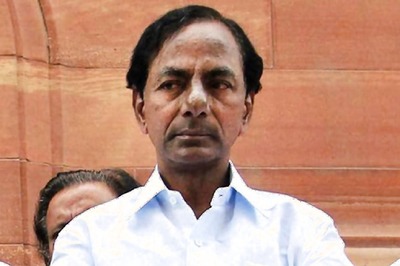
views
Ad-valorem duties: This Latin term refers to duties or taxes that are imposed on commodities based on their value.
Budgetary Deficit: When expenses exceed revenues, it leads to a situation of budgetary deficit. The entire budgetary exercise falls short of allocating enough funds to a certain area.
Budget Estimates: These estimates contain an annual estimate of Fiscal Deficit and Revenue Deficit and include the estimates of the Centre's spending during the financial year. It also contains the income received as proceeds of tax revenues.
Balance of Payment: The annual overall statement of a country's economic transactions – spending and income – with the rest of the world.
Bank Credit: This refers to the borrowing capacity advanced by a bank to an individual, firm or organization in the form of loans, cash credit and overdrafts.
Bank Rate: This is the interest rate at which the Reserve Bank of India advances short-term loans to commercial banks in the country. Changes in bank rate are reflected in the prime lending rates (PLRs) offered by commercial banks to their best customers.
Borrowings: When commercial banks receive something of value from the RBI against refinance schemes, like general refinance, and export credit refinance.
Cash Balances: Cash Balances with RBI indicate those maintained by scheduled banks with RBI and include these balances under cash reserve ratio (CRR) requirements.
Capital Budget: This plan keeps track of the Centre’s capital receipts and payments and accounts for market loans, borrowings from the Reserve Bank and other institutions through the sale of Treasury Bills, loans from foreign governments and recoveries of loans granted by the Central government to state governments and Union Territories.
Capital Payments: Refer to expenses incurred on acquisition of assets.
Cenvat: Central Value Added Tax (CENVAT) is a substitute for the earlier Modified Value Added Tax (MODVAT) scheme and is aimed at reducing the spiraling effect of indirect taxes on finished products.
Custom Duties: These taxes are imposed when goods are either imported or exported.
Countervailing Duties: Levied on imports that may lead to price rise in the domestic market. Seen as a means of discouraging unfair trade practices by other countries.
Consolidated Fund: This is a big reservoir where the Government pools all its funds including revenues, loans raised and recoveries of loans granted together.
Contingency Fund: As the name suggests, this is an emergency fund to help the Government tide over when in dire straits. The fund is at the disposal of the President and requires Parliament approval and the amount withdrawn from the fund is recouped.
Capital Expenditure: Capital expenditure (CAPEX) is the amount a company spends on buying fixed assets like land, building, machinery and equipment. Loans and advances sanctioned by the Centre to state governments, Union Territories and PSUs also fall in this category.
Capital Receipt: Loans raised by the Centre from the market, government borrowings from the RBI, sale of Treasury Bills and loans received from foreign governments all form a part of Capital Receipt. Other items in this category include recovery of loans granted by the Centre to states and UTs and proceeds from the dilution of the government's stake in PSUs.
PAGE_BREAK
Central Plan: Refers to the government's budgetary support to the Plan and the internal and extra budgetary resources raised by the PSUs.
Consumer price index: A price index covering the prices of consumer goods.
Corporate Tax: Tax levied on companies on the profit made by them.
Currency Liability: Comprises one, two and five-rupee coins and other small coinage, and commemorative coins issued by the government mints.
Current Account Transactions: A country's balance of payments on Current Account Transactions includes trade in goods or visibles; trade in services, or invisibles; payments of factor incomes, including dividends, interests, migrants remittances from earnings abroad; and international transfers, that is gifts.
Current Account Deficit: This is an excess of expenditure over receipts on current account in a country's balance of payments.
Current Account Surplus: This is an excess of receipts over expenditure on current account in a country's balance of payments.
Direct Taxes: Taxes which are imposed directly on consumers like Income Tax and Corporate Tax.
Disinvestment: The process of dilution of the government's stake in Public Sector Undertakings.
Demand for grants: A statement of estimate of expenditure from the Consolidated Fund and requires the approval of the Lok Sabha.
Demand deposits: Bank account that allows money to be withdrawn from the available balance by the account holder at his or her will and by any means, without notice to the bank.
Deposit money: Consists of demand deposits with commercial and cooperative banks and also includes current deposit portions of savings bank deposits. These deposits do not earn any interest.
Excise Duty: A tax levied on the consumption of particular goods and may be levied to raise government revenue. Excise duties are often levied at higher rates on goods like alcohol, tobacco and petrol whose consumption is believed to have adverse effects on public health, order and environment.
Foreign Direct Investment: The acquisition by residents of a country of real assets abroad and may be done by remitting money abroad to be spent on acquiring land, constructing buildings, mines, or machinery, or buying existing foreign business.
Finance Bill: This consists of the Government's proposals for the imposition of new taxes, modification of the existing tax structure or continuance of the existing tax structure beyond the period approved by Parliament.
Fiscal Deficit: It is the difference between the Revenue Receipts and Total Expenditure.
Gross Domestic Product (GDP): This is the value of a country’s overall output of goods and services during one fiscal year) at market prices, excluding net income from abroad. It thus includes activities carried out in the country by foreign-owned companies, and excludes activities of firms owned by residents but carried on abroad.
Gross National Product (GNP): This is the total market value of the finished goods and services manufactured within the country in a given financial year, plus income earned by the local residents from investments made abroad, minus the income earned by foreigners in the domestic market.
Gross Investment: Spending on creating new capital goods before making any allowance for capital consumption and consists of gross fixed investment, plus net investment in stocks and work in progress.
PAGE_BREAK
Income Tax: The tax levied on income made by individuals. Income tax is normally zero on some bands of small incomes, both on equity grounds and because of the expense of collecting tiny amounts of tax. It is normally proportional up to some upper limit; income beyond this is taxed at higher rates.
Inflation: A persistent tendency in the economy when prices and money wages are on the rise. Inflation is measured by the proportional changes over time in some appropriate index, commonly a consumer price index, or a GDP deflator.
Indirect Taxes: Imposed on goods manufactured, imported or exported such as Excise Duties and Custom Duties.
MODVAT: Modified Value Added Tax is a way of lending some relief to the final manufacturers of goods on excise duties borne by their suppliers.
Merchandise Account: The part of balance-of-payments accounts referring to visible trade or merchandise imports and exports.
Non-Plan Expenditure: This consists of Revenue and Capital Expenditure on interest payments, defence expenditure, subsidies, postal deficit, police, pensions, economic services, loans to public sector enterprises and loans as well as grants to state governments, UTs and foreign governments.
Peak Rate: It is the highest rate of custom duty applicable on an item.
Performance Budget: This is a compilation of programmes and activities of different ministries and departments.
Public Account: An account where money received through transactions not related to the consolidated fund is kept.
Plan Expenditure: This consists of both Revenue Expenditure and Capital Expenditure of the Centre on the Central Plan, central assistance to states and UTs.
Purchasing power parity (PPP): The rates of currency conversion which equalise the purchasing power of different currencies. This means that a given sum of money, when converted into different currencies at the PPP rates, will buy the same basket of goods and services in all countries.
Reserve money: A term which refers to money supplied by the RBI and the Centre. This indicates monetary liability of the RBI and the Government of India to the public, including banks. The reserve money, or currency notes and coins, is held by public and banks in their currency chests and as deposits with RBI. It also includes "other" deposits with RBI.
Revenue Deficit: The difference between Revenue Expenditure and Revenue Receipts.
Revenue Surplus: It is the excess of Revenue Receipts over Revenue Expenditure.
Revised Estimates: Usually tabled in the following Budget, it is the difference between the Budget Estimates and the actual figures.
Revenue Budget: Consists of Revenue Receipts and Revenue Expenditure of the government.
Revenue Receipt: Consists of duties imposed by the Centre, interest and dividend on investments made by the government.
Revenue Expenditure: Expenditure incurred for the normal functioning of the government departments and various other services such as interest charges on debt incurred by the government.
Subsidies: Financial aid provided by the Centre to individuals or a group of individuals to be competitive. The grant of subsidies is also aimed at improving their skills of those who benefit from the subsidies.
Term Deposits: Deposits with a fixed maturity of not less than 15 days, including cash certificates, and cumulative or recurring deposits but excluding the interest accrued and payable on these deposits.
Value Added Tax: Based on the difference between the value of the output over the value of the inputs used.
Wholesale Price Index: The prices of goods, which are dealt with wholesale, mainly bulk goods that are mostly inputs to production rather than finished commodities. A wholesale price index, for example, includes wheat and sheets of steel, whereas a retail price index includes bread and cars.

















Comments
0 comment